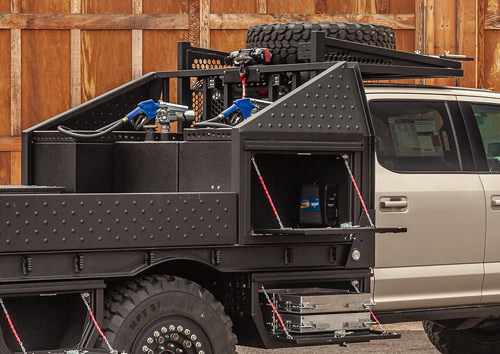Fuel Transfer Tanks For Pickup Trucks: Your Comprehensive Guide to Mobile Fuel Solutions pickup.truckstrend.com
In an increasingly mobile world, the ability to transport and dispense fuel on demand has become an indispensable asset for a diverse range of individuals and businesses. From farmers needing to refuel tractors in remote fields to contractors powering generators on construction sites, and from off-road enthusiasts extending their adventures to emergency responders requiring backup fuel, the reliance on external fuel sources is constant. This is where Fuel Transfer Tanks For Pickup Trucks step in, transforming your ordinary pickup into a versatile, mobile fueling station.
A fuel transfer tank, at its core, is a specialized container designed to safely store and transport various types of fuel, most commonly diesel, gasoline, or even DEF (Diesel Exhaust Fluid), within the bed of a pickup truck. Equipped with a pump, hose, and nozzle, these tanks allow users to conveniently dispense fuel directly into equipment, vehicles, or other containers, eliminating the need for frequent trips to a gas station and significantly enhancing operational efficiency. This guide will delve into every facet of fuel transfer tanks, providing you with the knowledge to make an informed decision and utilize them safely and effectively.
Fuel Transfer Tanks For Pickup Trucks: Your Comprehensive Guide to Mobile Fuel Solutions
Why Invest in a Fuel Transfer Tank? The Unbeatable Advantages
The benefits of owning a fuel transfer tank extend far beyond mere convenience, offering tangible advantages that impact productivity, cost-efficiency, and peace of mind.
- Unparalleled Convenience: Imagine never having to interrupt a critical task to drive to the nearest gas station. With a transfer tank, your fuel is always where you are, ready to dispense into excavators, generators, ATVs, boats, or even other vehicles. This on-site fueling capability minimizes downtime and maximizes operational hours.
- Significant Cost Savings: Purchasing fuel in bulk often comes with a lower per-gallon price, especially for diesel. Over time, these savings can add up considerably, offsetting the initial investment in the tank. Furthermore, avoiding premium prices at remote or less competitive fueling stations contributes to long-term financial benefits.
- Enhanced Productivity: Every minute spent driving to and from a gas station is a minute lost on the job. By bringing the fuel to your equipment, you keep your machinery running and your crew working, leading to higher output and more projects completed on schedule.
- Emergency Preparedness: A full transfer tank can be a lifeline during power outages, natural disasters, or unexpected emergencies. It ensures you have fuel for generators, chainsaws, and even your own vehicles when traditional fueling stations are inaccessible or out of service.
- Versatility for Various Applications: Whether you’re a landscaper, logger, construction worker, rancher, or an avid outdoorsman, a transfer tank adapts to your specific needs. They are designed to handle different fuel types, making them a universal solution for diverse equipment.
- Reduced Wear and Tear on Equipment: Regularly running equipment dry can lead to air in fuel lines and potential damage to fuel pumps. Having fuel readily available encourages timely refueling, contributing to the longevity of your machinery.

Types of Fuel Transfer Tanks: Choosing Your Perfect Match
Fuel transfer tanks come in various configurations, each designed to meet specific needs and preferences. Understanding these types is crucial for making the right choice.
By Material:

- Aluminum Tanks: Lightweight, corrosion-resistant, and durable, aluminum tanks are a popular choice. They don’t add excessive weight to your truck’s payload capacity and are less prone to rust, making them ideal for long-term use in various climates.
- Steel Tanks: Known for their robust strength and lower cost, steel tanks offer excellent durability. They are heavier than aluminum but provide a sturdy option for those prioritizing ruggedness and budget. Many are powder-coated for enhanced corrosion resistance.
By Capacity:

Transfer tanks are available in a wide range of capacities, from compact options for occasional use to large tanks for commercial applications. Common sizes include:
- Small (50-75 gallons): Ideal for light-duty use, recreational purposes, or smaller operations.
- Medium (75-100 gallons): A popular choice for many contractors and farmers, offering a good balance of capacity and manageability.
- Large (100-200+ gallons): Suited for heavy commercial use, large farms, or remote job sites requiring substantial fuel reserves.
By Design/Mounting:
- Rectangular/Square Tanks: These are the most common design, fitting neatly against the bulkhead of the truck bed or behind the cab.
- L-Shaped Tanks: Designed to fit over the wheel wells in the truck bed, allowing for more efficient use of space and leaving room for toolboxes or other cargo.
- Auxiliary/Combo Tanks: Some tanks incorporate an additional storage compartment for tools or equipment, offering a multi-functional solution.
By Fuel Type Specificity:
- Diesel Tanks: The most common type, these tanks are designed for diesel fuel. They typically have simpler venting requirements.
- Gasoline Tanks: Crucially, gasoline transfer tanks must be UL-listed (Underwriters Laboratories) for gasoline use. They require more robust venting systems to handle volatile gasoline vapors safely and are often built with thicker materials to prevent static discharge.
- DEF Tanks: Dedicated tanks for Diesel Exhaust Fluid are also available, often made from specific plastics to prevent contamination and corrosion.
By Pumping System:
- 12V Electric Pumps: The most popular option, these pumps connect directly to your truck’s 12V battery, offering fast and convenient fueling with the flick of a switch. Flow rates typically range from 8-20 GPM (gallons per minute).
- Hand Pumps: Manual pumps are a cost-effective and reliable option that doesn’t require an external power source. While slower, they are excellent for backup or situations where electricity isn’t available.
Key Features to Look For: Safety and Performance Essentials
When investing in a fuel transfer tank, paying attention to specific features can significantly impact its safety, durability, and overall performance.
- Robust Construction: Look for high-quality welds, thick gauge aluminum or steel, and a durable finish (like powder coating) that can withstand harsh environments and prevent corrosion.
- Reliable Pumping System: Consider the pump’s flow rate (GPM), motor duty cycle, and the quality of the hose and nozzle. A higher GPM means faster fueling, while a durable hose and auto-shutoff nozzle enhance convenience and safety.
- Adequate Venting System: Proper venting is critical for safe operation, especially with gasoline. It allows air to enter the tank as fuel is drawn out and releases pressure built up by temperature changes.
- Internal Baffles: For larger tanks, baffles are internal plates that prevent fuel from sloshing excessively during transport. This improves vehicle stability and reduces wear on the tank.
- Secure Mounting Points: Ensure the tank has robust mounting tabs or channels that allow for secure bolting to the truck bed.
- Fuel Gauge: An integrated fuel gauge helps you monitor fuel levels, preventing unexpected run-outs.
- Filtration System: Some pumps include a fuel filter to ensure clean fuel is dispensed, protecting your equipment’s fuel system.
- Compliance and Certifications: For gasoline tanks, UL-listing is non-negotiable. For commercial use, ensure the tank meets DOT (Department of Transportation) regulations.
Installation and Safety Guidelines: Operating with Confidence
Proper installation and adherence to safety protocols are paramount when operating a fuel transfer tank.
Installation:
- Check Payload Capacity: Before purchasing, confirm your truck’s payload capacity. Fuel is heavy (diesel ~7 lbs/gallon, gasoline ~6 lbs/gallon). A 100-gallon tank full of diesel adds 700 lbs, plus the tank’s weight.
- Secure Mounting: The tank must be securely bolted to the truck bed to prevent shifting during transit. Use heavy-duty bolts and large washers or backing plates to distribute the load. Do not rely on straps alone.
- Electrical Connections (for electric pumps): Connect the pump’s power leads directly to the truck’s battery. Use appropriate gauge wire, an inline fuse, and ensure all connections are watertight and protected from chafing.
- Grounding: Always ensure the tank and pump are properly grounded to the truck frame to dissipate static electricity, especially when dispensing flammable fuels.
Safety Guidelines:
- No Smoking/Open Flames: This is the most fundamental rule. Fuel vapors are highly flammable.
- Proper Ventilation: Ensure adequate ventilation when fueling, especially in enclosed spaces.
- Grounding During Dispensing: Before dispensing fuel, connect a grounding cable from the tank to the equipment being fueled to equalize static charges.
- Spill Preparedness: Keep a spill kit (absorbent pads, containment socks) readily available. Know how to respond to a fuel spill.
- Never Overfill: Always leave some air space for fuel expansion, especially in hot weather.
- Regular Inspections: Periodically check hoses for cracks, connections for leaks, and the pump for proper operation.
- Know Your Fuel: Understand the properties of the fuel you are transporting and the specific safety requirements.
Legal and Regulatory Considerations: Staying Compliant
Transporting fuel, especially in larger quantities, is subject to various federal, state, and local regulations. While specific rules can vary, here are general considerations:
- DOT Regulations: For commercial operators, the Department of Transportation (DOT) has regulations regarding the transport of hazardous materials. Quantities exceeding certain thresholds (e.g., 119 gallons for diesel, less for gasoline) may require specific placarding, driver endorsements, and tank certifications. Always check current DOT guidelines (e.g., CFR 49 Part 173).
- UL Certification: For gasoline, UL (Underwriters Laboratories) certification is critical. It indicates the tank meets rigorous safety standards for storing and dispensing flammable liquids.
- State and Local Laws: Some states or municipalities may have specific ordinances regarding fuel transport, particularly concerning residential areas or environmental protection zones. Always verify local regulations.
- Insurance: Inform your insurance provider if you plan to transport significant quantities of fuel, especially for commercial purposes, to ensure adequate coverage in case of an incident.
Choosing the Right Fuel Transfer Tank for Your Needs
Selecting the ideal transfer tank involves a careful assessment of your specific requirements:
- Intended Use: Are you a homeowner needing occasional fuel for a lawnmower, a farmer refueling multiple tractors daily, or a contractor powering heavy machinery? This dictates capacity and features.
- Fuel Type: Will you be transporting diesel, gasoline, or both? This determines the tank’s certification requirements.
- Required Capacity: How much fuel do you realistically need to transport per trip? Consider the fuel consumption of your equipment and the frequency of use.
- Truck Compatibility: Ensure the tank’s dimensions and weight (when full) are compatible with your truck’s bed size and payload capacity.
- Budget: Set a realistic budget, remembering that investing in a quality tank with proper safety features is a long-term investment.
Practical Advice and Actionable Insights
- Don’t Overload: Always be mindful of your truck’s Gross Vehicle Weight Rating (GVWR). An overloaded truck is unsafe and illegal.
- Buy Quality: While cheaper tanks exist, compromise on quality, especially concerning safety features and pump reliability, can lead to costly and dangerous problems down the line.
- Filter Your Fuel: Consider an inline fuel filter on your pump to prevent contaminants from reaching your valuable equipment.
- Plan Your Routes: If transporting large quantities, plan routes that minimize sudden stops and turns to reduce fuel sloshing.
- Regular Maintenance: Treat your transfer tank like any other piece of valuable equipment. Regular checks and maintenance will ensure its longevity and safe operation.
Fuel Transfer Tank Price Table (Estimated)
Please note: Prices are highly variable based on brand, features, material, and retailer. These are general estimates for new tanks and pumps. Installation costs are typically separate.
| Tank Type/Material | Capacity Range (Gallons) | Pump Type | Key Features | Estimated Price Range (USD) |
|---|---|---|---|---|
| Aluminum | 50-75 | 12V Electric (8-15 GPM) | Lightweight, corrosion-resistant, often with baffles | $800 – $1,500 |
| 100-150 | 12V Electric (10-20 GPM) | Durable, internal baffles, integrated fuel gauge | $1,500 – $2,500 | |
| 200+ | 12V Electric (15-20 GPM) | Heavy-duty, large capacity, often with toolboxes/L-shape | $2,500 – $4,000+ | |
| Steel | 50-75 | 12V Electric (8-15 GPM) | Robust, powder-coated, more economical | $600 – $1,200 |
| 100-150 | 12V Electric (10-20 GPM) | Heavy-duty, strong welds, often with toolboxes | $1,200 – $2,000 | |
| 200+ | 12V Electric (15-20 GPM) | Max durability, large volume, commercial grade | $2,000 – $3,500+ | |
| Gasoline (UL-Listed) | 50-100 | 12V Electric (8-15 GPM) | UL-listed for gasoline, specialized venting, heavier gauge steel/alum. | $1,200 – $2,500 |
| Hand Pump Only | 50-100 | Manual Hand Pump | No power needed, simple, cost-effective, slower GPM | $400 – $800 |
| Tank Only (No Pump) | Various | N/A | Tank only, requires separate pump purchase | $300 – $2,000+ |
| Accessories | N/A | N/A | Hoses, nozzles, filters, meters, grounding kits | $50 – $500+ (per item) |
Frequently Asked Questions (FAQ)
Q1: Can I transport gasoline in any fuel transfer tank?
A1: Absolutely not. Gasoline is highly volatile and requires a tank specifically designed and UL-listed (Underwriters Laboratories) for gasoline use. These tanks have enhanced safety features, including specialized venting and construction, to handle flammable vapors safely. Using a non-UL-listed tank for gasoline is extremely dangerous and illegal.
Q2: How do I securely mount the tank in my truck bed?
A2: Fuel transfer tanks must be securely bolted to the truck bed. Most tanks come with pre-drilled mounting tabs. Use heavy-duty bolts, large washers, and potentially a backing plate beneath the truck bed to distribute the weight and prevent the bolts from pulling through. Never rely solely on straps.
Q3: Are fuel transfer tanks legal to use on public roads?
A3: Yes, generally, fuel transfer tanks are legal for transport, but regulations vary by federal, state, and local laws, especially for commercial use and large quantities. Always check DOT (Department of Transportation) regulations for specific placarding, driver endorsements, and tank certifications if you exceed certain volume thresholds or are transporting for commercial purposes.
Q4: What’s the difference between a diesel transfer tank and a gasoline transfer tank?
A4: The primary difference lies in safety features and certifications. Gasoline tanks require much more robust venting systems to safely handle highly flammable vapors and must be UL-listed. Diesel is less volatile and requires simpler venting, so diesel-specific tanks typically don’t carry the same stringent certifications.
Q5: How often should I perform maintenance on my fuel transfer tank?
A5: Regular maintenance is crucial. Before each use, visually inspect hoses for cracks, connections for leaks, and the nozzle for proper operation. Check electrical connections for corrosion. Annually, perform a more thorough inspection of the tank’s integrity, pump performance, and ensure all safety features (like vents) are clear and functional.
Q6: What size fuel transfer tank do I need?
A6: The ideal size depends on your specific needs. Consider the fuel consumption of your equipment, how often you need to refuel, and the distance to the nearest fuel station. Also, importantly, check your truck’s payload capacity to ensure it can safely carry the weight of the full tank.
Q7: Can I use a transfer tank for other liquids, like water?
A7: While physically possible, it’s generally not recommended to use a fuel transfer tank for water or other liquids, especially after it has contained fuel. Residual fuel can contaminate the water, making it unusable or even hazardous for certain applications. Dedicated water tanks are a better choice.
Conclusion
Fuel transfer tanks for pickup trucks are more than just accessories; they are powerful tools that enhance efficiency, save money, and provide critical flexibility for a wide array of users. By transforming your pickup into a mobile fueling station, you gain the freedom to operate equipment wherever and whenever it’s needed, minimizing downtime and maximizing productivity.
However, the power and convenience of these tanks come with a significant responsibility. Understanding the different types, choosing the right features, ensuring proper installation, and strictly adhering to safety guidelines and legal regulations are paramount. Invest wisely, operate safely, and your fuel transfer tank will prove to be an invaluable asset, empowering you to tackle tasks with unparalleled autonomy and efficiency.



